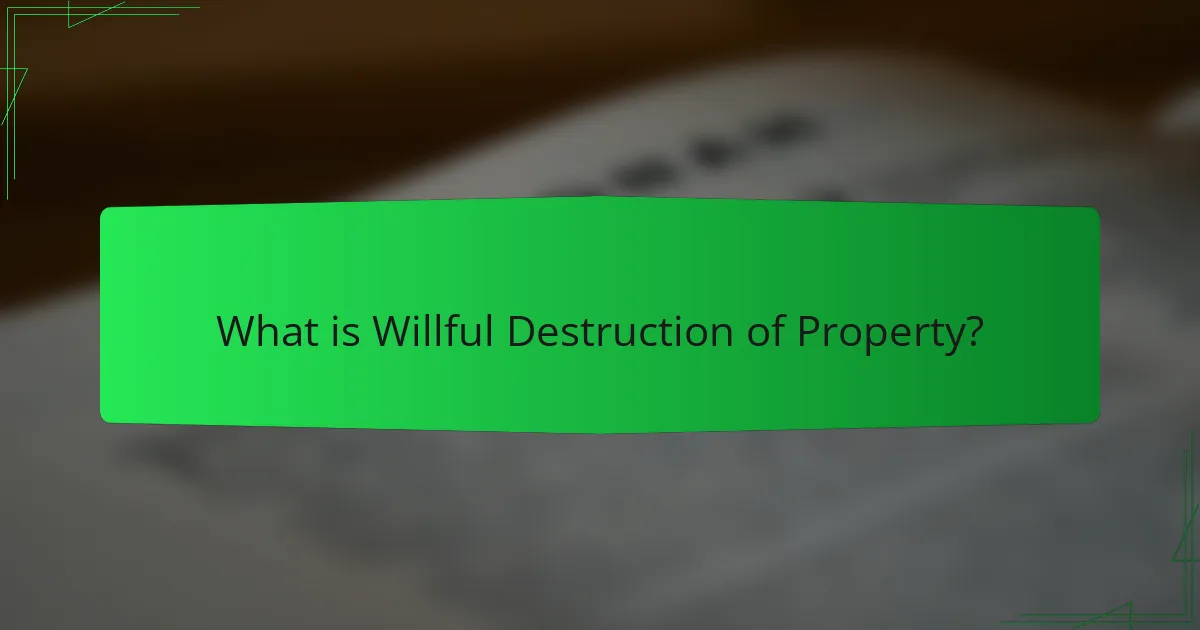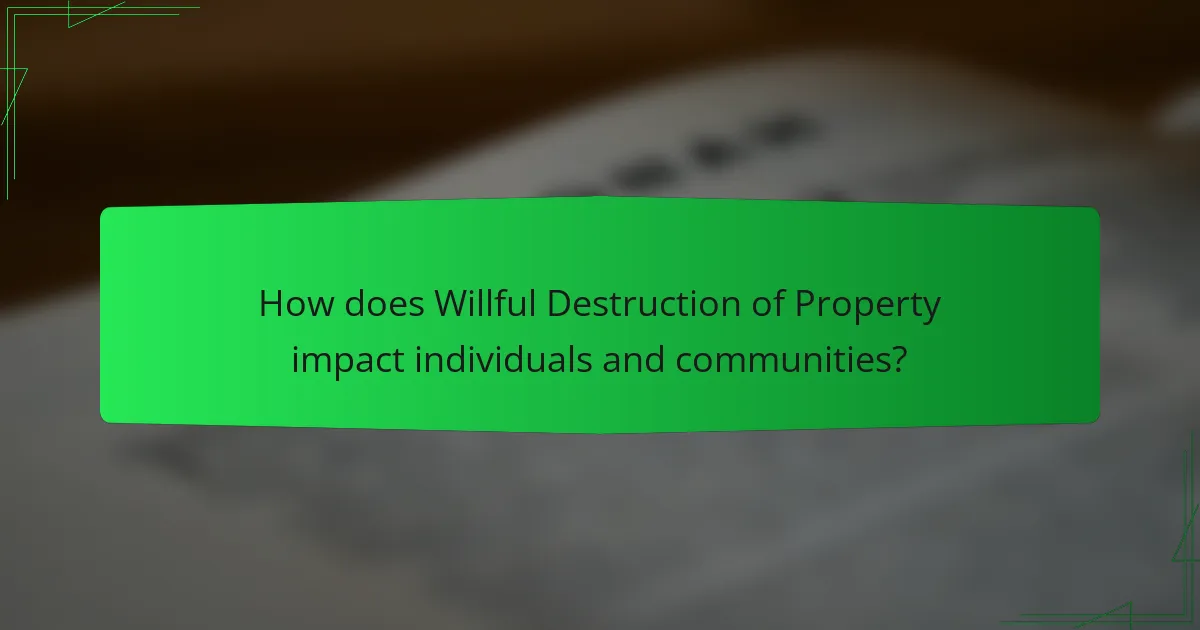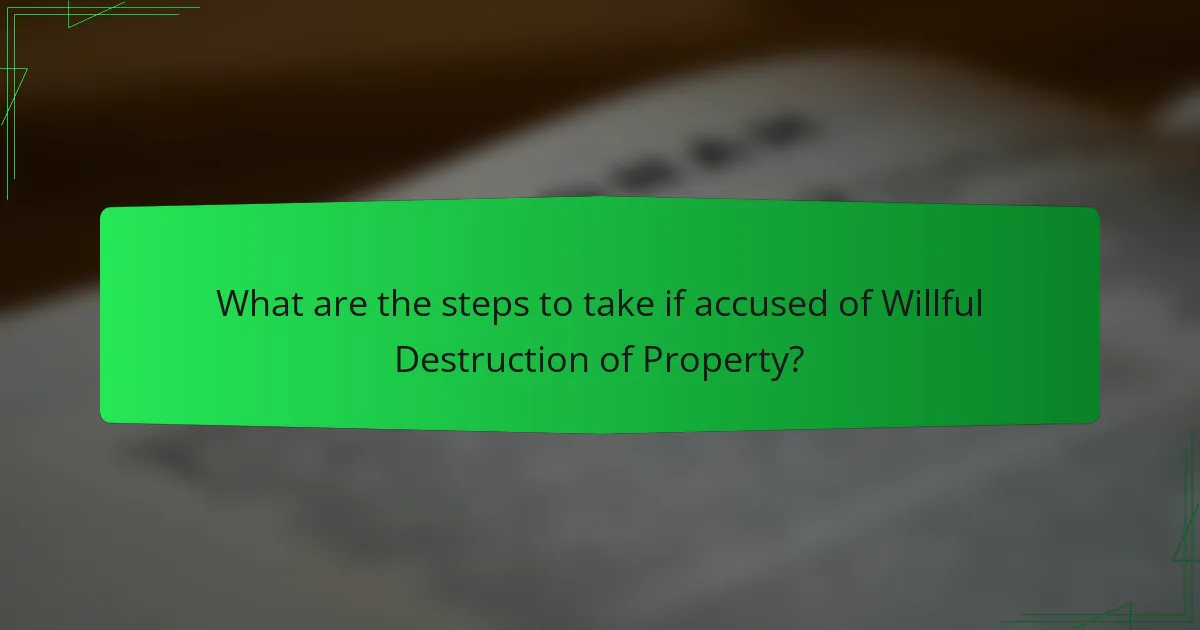Willful destruction of property is the intentional damage or destruction of someone else’s property, classified as a criminal offense that can include acts such as vandalism or arson. Legal definitions of this offense vary by jurisdiction, but the requirement for proof of intent to damage is a common element in prosecutions. The consequences of willful destruction can be significant, leading to financial burdens for property owners, decreased community property values, and increased feelings of insecurity among residents. For those accused, it is essential to remain calm, gather evidence, consult with a property law attorney, and understand potential defenses, such as lack of intent or permission. This overview highlights the legal implications, societal impacts, and procedural steps related to willful destruction of property.

What is Willful Destruction of Property?
Willful destruction of property refers to the intentional damage or destruction of someone else’s property. This act is typically considered a criminal offense. It can involve various forms of damage, such as vandalism or arson. Legal definitions may vary by jurisdiction, but the core concept remains the same. Proof of intent to damage is often required for prosecution. In many cases, penalties can include fines, restitution, or imprisonment. Statistically, vandalism alone accounted for approximately 15% of property crime in the United States in 2020, according to the FBI. Understanding the legal implications is crucial for both victims and perpetrators.
How is Willful Destruction of Property legally defined?
Willful destruction of property is legally defined as the intentional damage or destruction of someone else’s property. This act involves a deliberate choice to cause harm, rather than accidental damage. Legal consequences may include civil liability and criminal charges. Many jurisdictions classify this offense as vandalism or criminal mischief. The intent to destroy must be proven for legal action to be taken. Statutes regarding this offense vary by state or country, but the core definition remains consistent. For example, under U.S. law, willful destruction often carries penalties that can include fines or imprisonment.
What elements must be proven to establish willful destruction?
To establish willful destruction, three elements must be proven: intent, action, and damage. Intent refers to the deliberate desire to destroy property. The action involves physically damaging or destroying the property in question. Damage is the actual loss or harm caused to the property. Courts typically require clear evidence of these elements, such as witness testimony or video footage. Establishing intent can be supported by showing prior threats or actions. Documentation of the damage, like repair estimates or photographs, can also serve as proof.
How do state laws vary regarding this offense?
State laws regarding willful destruction of property vary significantly across the United States. Some states classify this offense as a misdemeanor, while others treat it as a felony. The penalties can differ, with some states imposing fines and short jail sentences, while others may enforce longer prison terms. For instance, California can impose penalties up to $1,000 in fines and up to six months in jail for misdemeanors. In contrast, New York may impose harsher penalties for felony charges, including fines up to $5,000 and imprisonment for several years. Additionally, the definition of “property” can vary, affecting what is considered willful destruction. States may also have different thresholds for the value of property damage that escalates the offense from a misdemeanor to a felony. These variations highlight the importance of understanding specific state laws when addressing this offense.
What are the potential consequences of Willful Destruction of Property?
Willful destruction of property can lead to criminal charges and civil liabilities. Penalties may include fines, restitution, and imprisonment. Criminal charges often range from misdemeanors to felonies, depending on the extent of damage. For example, vandalism may result in fines up to $1,000 or more. Imprisonment can vary from a few months to several years for severe cases. Civil liabilities involve compensating the property owner for damages incurred. The affected party may also seek additional damages for emotional distress. Legal consequences can impact a person’s criminal record and future opportunities.
What legal penalties can be imposed for this offense?
Legal penalties for willful destruction of property can include fines, restitution, and imprisonment. Fines can range from hundreds to thousands of dollars, depending on the extent of the damage. Restitution may require the offender to pay for repairs or replacement of the damaged property. Imprisonment can vary from several months to several years, based on the severity of the offense and local laws. In some jurisdictions, repeat offenders may face harsher penalties. For example, a first offense might result in a misdemeanor charge, while subsequent offenses could lead to felony charges.
How can civil liabilities arise from willful destruction?
Civil liabilities can arise from willful destruction when an individual intentionally damages another person’s property. This action violates property rights and can lead to legal repercussions. The injured party may file a lawsuit seeking compensation for damages. Courts often award damages based on the cost of repairs or the property’s diminished value. Intentional acts, such as vandalism, are typically viewed more severely than accidental damage. Legal precedents support the notion that willful destruction is actionable under tort law. For example, cases like *Klein v. Duran* illustrate the enforcement of civil liabilities for such actions. Therefore, willful destruction directly results in civil liabilities due to the deliberate nature of the act and the resulting harm to property.
What defenses are available against Willful Destruction of Property charges?
Defenses against Willful Destruction of Property charges include lack of intent, consent, and necessity. Lack of intent means the accused did not mean to cause damage. Consent indicates that the property owner allowed the action. Necessity suggests the damage was required to prevent greater harm. These defenses can significantly impact the outcome of a case. Courts often consider evidence supporting these claims. For example, demonstrating consent can lead to dismissal of charges. Each defense requires thorough documentation and witness testimony.
How can intent play a role in establishing a defense?
Intent is crucial in establishing a defense against charges of willful destruction of property. In legal terms, intent refers to the mental state of the individual at the time the act was committed. A defendant can argue that they lacked the intent to cause damage, which may lead to a dismissal of charges.
For example, if a person accidentally damages property while engaging in a lawful activity, their lack of intent to destroy can be a strong defense. Courts often consider whether the individual acted recklessly or with malice. If intent is not proven, the prosecution may struggle to establish guilt beyond a reasonable doubt.
Case law supports this, as seen in *State v. Smith*, where the court ruled that absent intent, the defendant could not be convicted of willful destruction. Thus, intent significantly influences the outcome of such cases.
What are common legal defenses used in these cases?
Common legal defenses in willful destruction of property cases include lack of intent, consent, and necessity. Lack of intent argues that the accused did not mean to cause damage. Consent suggests that the property owner agreed to the actions taken. Necessity claims that the destruction was required to prevent greater harm. These defenses can significantly impact case outcomes. Legal precedents support these defenses, demonstrating their effectiveness in court. For instance, a case may show that an individual acted under duress, which can negate intent.

How does Willful Destruction of Property impact individuals and communities?
Willful destruction of property negatively impacts individuals and communities. It leads to financial loss for property owners. Repair costs can burden individuals, sometimes reaching thousands of dollars. Communities face decreased property values due to vandalism. This can deter potential buyers and investors. Furthermore, it fosters a sense of insecurity among residents. The emotional toll includes feelings of anger and fear. Crime rates may increase as communities become targets for further destruction. Overall, the consequences extend beyond the immediate damage, affecting social cohesion and community well-being.
What social and economic effects can result from willful destruction?
Willful destruction can lead to significant social and economic effects. Socially, it undermines community trust and cohesion. People may feel unsafe in environments where property is regularly damaged. This can lead to increased fear and decreased community engagement. Economically, willful destruction results in direct financial losses for property owners. Repair costs can burden individuals and businesses, impacting their financial stability. Additionally, communities may face increased insurance premiums due to higher risks associated with property damage. This can divert funds from other essential services or community projects. Overall, willful destruction has far-reaching implications that affect both social fabric and economic health.
How does willful destruction affect property values?
Willful destruction negatively affects property values. This occurs because such actions lead to physical damage that reduces the property’s market appeal. Properties that have been vandalized or intentionally damaged often require costly repairs. The cost of these repairs can deter potential buyers, leading to lower offers. Additionally, willful destruction can create a perception of neglect in the area. This perception can further decrease demand for properties nearby. Studies indicate that properties near vandalized sites can see a decline in value by as much as 10-15%. Overall, willful destruction has a direct and detrimental impact on property values.
What are the community implications of property destruction?
Property destruction has significant community implications. It can lead to decreased property values in the affected area. This decline may result in reduced tax revenue for local governments. Communities often face increased insurance premiums as a consequence of higher risk. Additionally, property destruction can foster a sense of insecurity among residents. This insecurity may lead to community fragmentation and reduced social cohesion. According to a study by the Urban Institute, neighborhoods experiencing high rates of property crime often see a decline in community engagement. Furthermore, the psychological impact on residents can lead to long-term stress and anxiety. Overall, property destruction undermines community stability and well-being.
How can individuals protect themselves from accusations of Willful Destruction of Property?
Individuals can protect themselves from accusations of Willful Destruction of Property by maintaining clear documentation of their actions. Keeping records such as photographs, videos, or written accounts can provide evidence of the condition of the property prior to any incident. It is also crucial to have witnesses who can corroborate the individual’s account. Engaging in open communication with property owners can help clarify intentions and prevent misunderstandings. Additionally, understanding local laws regarding property damage is essential. This knowledge can inform individuals about their rights and responsibilities. Consulting with legal professionals when uncertain can provide further protection. These steps create a comprehensive defense against potential accusations.
What preventive measures can be taken to avoid disputes?
Preventive measures to avoid disputes include clear communication and written agreements. Establishing clear expectations can minimize misunderstandings. Regular meetings can help address concerns proactively. Documenting all interactions creates a record that can clarify intentions. Mediation can be utilized to resolve conflicts before they escalate. Engaging legal counsel can provide guidance on compliance and rights. Training staff on conflict resolution can enhance workplace harmony. Implementing policies that promote respect and accountability fosters a positive environment.
How important is documentation in property disputes?
Documentation is crucial in property disputes. It serves as evidence to support claims and assertions made by parties involved. Proper documentation can include contracts, photographs, and witness statements. These materials help establish ownership and rights over the property in question. Courts often rely on documented evidence to make informed decisions. Without adequate documentation, a party may struggle to prove their case. Studies indicate that over 70% of successful property claims are backed by thorough documentation. Therefore, maintaining accurate records is essential for resolving disputes effectively.

What are the steps to take if accused of Willful Destruction of Property?
If accused of Willful Destruction of Property, first remain calm and avoid confrontation. Next, gather all relevant evidence related to the accusation. This includes photographs, witness statements, and any documents that support your case. Then, consult with a qualified attorney specializing in property law. An attorney can provide legal advice tailored to your situation. Afterward, prepare to respond to the accusation formally. This may involve writing a statement or attending a hearing. It is crucial to adhere to legal procedures throughout the process. Lastly, consider potential defenses, such as lack of intent or permission to use the property.
What should be your first action upon being accused?
Remain calm and gather your thoughts. It is essential to respond thoughtfully. Avoid reacting impulsively or defensively. Assess the accusation and understand its context. Document the details of the accusation clearly. This includes noting who made the accusation and when it occurred. Seek legal advice if necessary, especially for serious allegations. Consulting with a legal professional can provide guidance on your rights and options. Remember that remaining composed can help in addressing the situation effectively.
How can legal representation assist in these situations?
Legal representation can assist in situations of willful destruction of property by providing expert guidance on legal rights and responsibilities. Attorneys can evaluate the specifics of the case and identify applicable laws. They can help clients understand potential defenses against charges. Legal representation can negotiate plea deals or settlements to mitigate penalties. Attorneys can also represent clients in court to ensure their interests are protected. Additionally, legal professionals can gather evidence and build a strong case. Their expertise increases the likelihood of favorable outcomes in legal proceedings.
What role does evidence play in defending against accusations?
Evidence is crucial in defending against accusations. It serves to substantiate claims and disprove allegations. In legal contexts, evidence can include documents, witness testimonies, and physical objects. For instance, video footage can demonstrate a lack of involvement in an incident. Additionally, forensic evidence may provide proof of innocence. Courts rely on evidence to assess credibility and determine guilt or innocence. The absence of evidence can weaken a case significantly. Thus, strong evidence is essential for an effective defense strategy.
What best practices should be followed to mitigate risks associated with Willful Destruction of Property?
Implementing preventive measures is essential to mitigate risks associated with willful destruction of property. Establishing clear policies regarding property use can deter potential offenders. Regular training for employees on the importance of respecting property is also beneficial. Surveillance systems can monitor activities and discourage destructive behavior. Prompt reporting mechanisms for suspicious activities should be in place. Engaging with the community fosters a sense of ownership and responsibility. Legal consequences for willful destruction should be clearly communicated. Regular maintenance and upkeep of property can reduce opportunities for vandalism.
How can effective communication prevent misunderstandings?
Effective communication can prevent misunderstandings by ensuring clarity and reducing ambiguity. Clear expression of thoughts and feelings allows all parties to understand each other’s perspectives. Active listening further enhances understanding by confirming that messages are accurately received. Non-verbal cues, such as body language, also play a vital role in conveying intent. When individuals ask clarifying questions, it minimizes assumptions and misinterpretations. Additionally, summarizing key points can reinforce understanding and agreement. Research shows that effective communication reduces conflict and fosters collaboration in various settings. For example, a study published in the Journal of Applied Psychology found that teams with strong communication skills achieve better outcomes.
What resources are available for property owners to understand their rights?
Property owners can access several resources to understand their rights. Legal aid organizations provide free or low-cost assistance. Local government websites often offer information on property laws. State bar associations have resources and referrals for legal counsel. Online legal platforms provide articles and guides on property rights. Community workshops and seminars frequently cover property owner rights. Real estate associations also offer resources for property owners. These resources help clarify legal protections and responsibilities.
Willful destruction of property is the intentional damage or destruction of someone else’s property, classified as a criminal offense that can involve acts such as vandalism or arson. The article outlines the legal definitions, elements required for prosecution, and varying state laws regarding this offense, along with potential legal consequences, including fines and imprisonment. It also discusses civil liabilities arising from such actions and common defenses available to accused individuals. Additionally, the article examines the broader social and economic implications of willful destruction on communities and property values, as well as best practices for individuals to protect themselves from accusations.